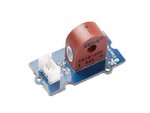brunofunchas
Full Member level 3

Hello!
I have a project where I have to reads the current of a compressor. It has a nominal current of 4,5A and the maximum of the board is 5A:
https://www.seeedstudio.com/Grove-Electricity-Sensor-p-777.html
My doubt is when the compressor kicks in, the inrush current can burn the input of the ESP32?
Is there a way to prevent it?
I have a project where I have to reads the current of a compressor. It has a nominal current of 4,5A and the maximum of the board is 5A:
https://www.seeedstudio.com/Grove-Electricity-Sensor-p-777.html
My doubt is when the compressor kicks in, the inrush current can burn the input of the ESP32?
Is there a way to prevent it?



